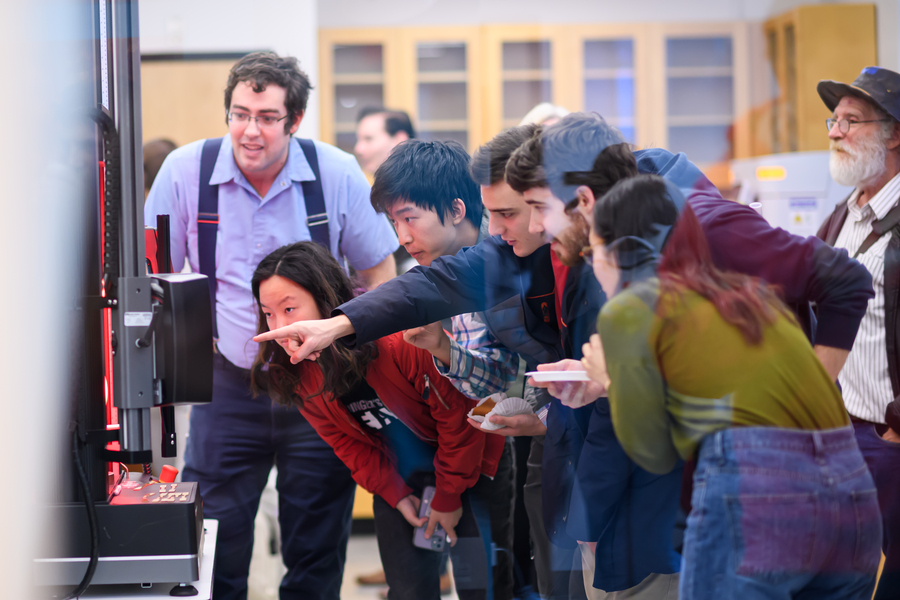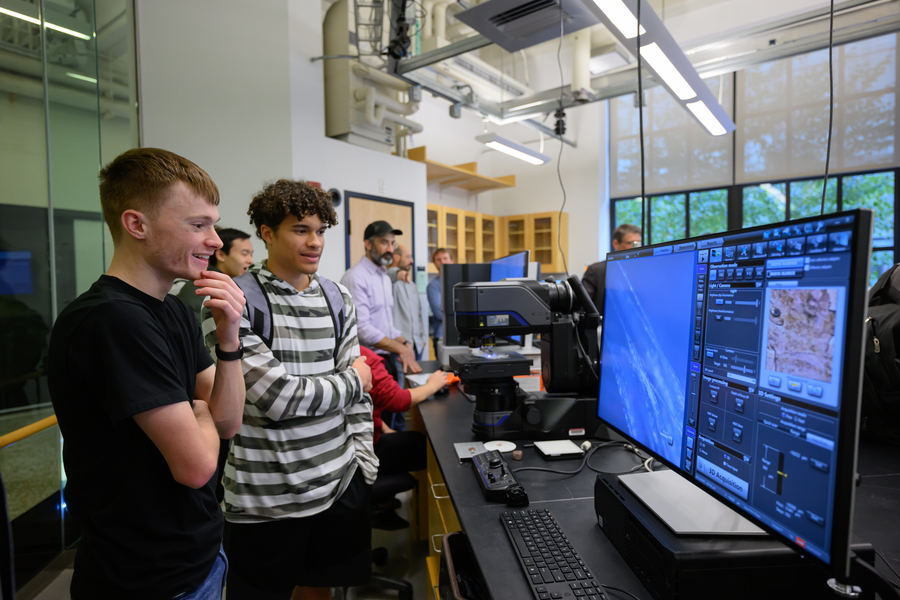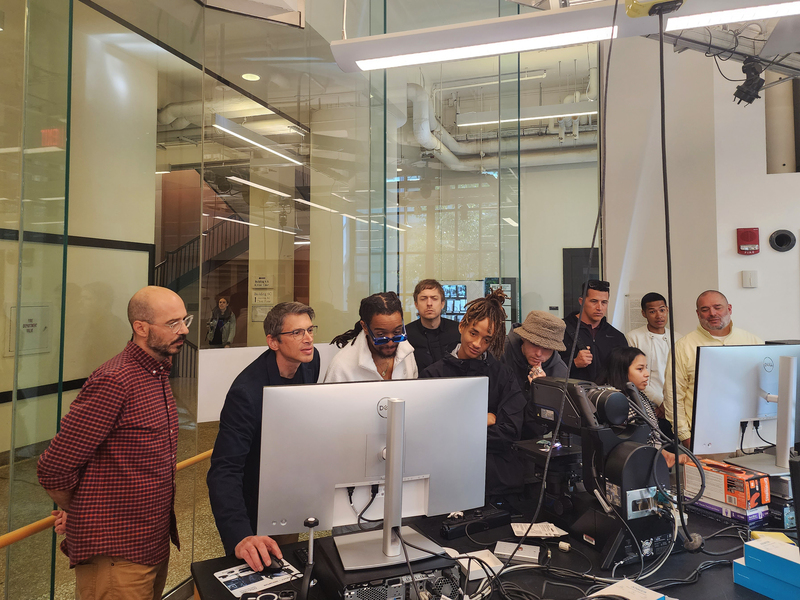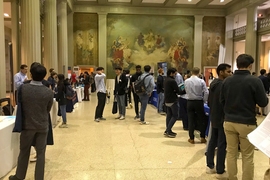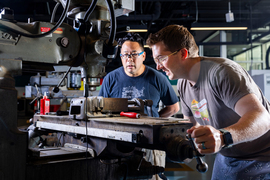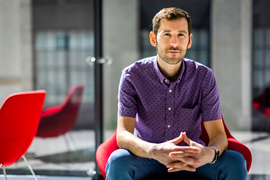Days before the opening of the Breakerspace, a new laboratory and lounge at MIT, actor and rapper Jaden Smith tried out the facility’s capabilities, putting his bracelet under a digital optical microscope. On the screen in front of him was a 3D rendering of woven threads, each strand made up of smaller strands, with specks of matter dotting the surface.
“His eyes just lit up,” says Professor Jeffrey Grossman, the Morton and Claire Goulder and Family Professor in Environmental Systems in the Department of Materials Science and Engineering (DMSE). Smith used a mouse-operated control to home in on the strands, magnifying them 8,000 times. Grossman recalls, “In four minutes, Jaden said, ‘That could be my next album cover.’”
Grossman and Smith have stayed in touch since 2017, when the then-19-year-old star toured campus and sat in on class 3.091 (Introduction to Solid-State Chemistry), which Grossman was teaching at the time. When Smith called in October to say he would be in Cambridge, Grossman invited him to test drive the Breakerspace, which he describes as a hands-on materials exploration space for all undergraduates, regardless of major.
“Curiosity of what the world is made of transcends all disciplines,” Grossman says. “Jaden’s not a material scientist, but he got inspired. And there’s a lot of potential for the space to do that for our students, across disciplines.”
The Breakerspace, equipped with microscopes and other instruments for exploring the composition, structure, and behavior of materials, is the “crown jewel” of DMSE’s strategic vision, Grossman says. The aim is to highlight materials science and engineering — an interdisciplinary field that incorporates chemistry, physics, and engineering principles to understand the materials that make up the world — and articulate its impact.
“Our discipline is about unraveling the mysteries of materials at the atomic level and then using that knowledge to tackle some of the world’s most pressing challenges — in energy, manufacturing, computing, health care, and more,” says Grossman, who until August was DMSE’s department head. “The Breakerspace is all about sharing that excitement and exploration.”
Breaking in the Breakerspace
The facility, under construction over the summer months, opened to the public on Nov. 8, dubbed Breakerday. In the three-hour opening event, nearly 300 people passed through the doors of 8-102, a glass-enclosed space on the Infinite Corridor, one of MIT’s busiest thoroughfares, as DMSE faculty, lecturers, and students gave demos of their capabilities.
A giant image on the wall projected from the digital optical microscope skimmed over the shaft and barbs of a feather. A scanning electron microscope (SEM), which scans a beam of electrons over an object, zoomed in on the Boston landscape etched into someone’s “Brass Rat,” the MIT class ring. And a tensile test machine, used to test the strength of materials, very slowly pulled apart a metal bar. A half-circle of students watched the machine in silence for a long stretch before a loud pop startled the group. DMSE technical instructor Shaymus Hudson, leading the demo, succinctly explained how testing materials helps engineers better understand and optimize them.
“If you can spot where the metal failed and understand why, you can make it not fail,” Hudson said.
In the lounge-half of the facility, people queued up for espressos and Americanos brewed from a café-quality Italian coffee machine.
“The lounge offers a comfortable setting for creative thinking and socializing,” says Breakerspace manager Justin Lavallee. “I think it will bring in a bigger pool of people than the lab alone. I’m curious to see how the community will build and how the lounge might drive that.”
The promise of great coffee on Breakerday clinched the deal for Kaitlyn Li, a first-year student with an interest in chemical engineering, a field adjacent to materials science and engineering. She learned about the Breakerspace from an email.
“When I read it came with coffee, I was like, ‘That sounds great!’” Li says.
Hands-on learning
The idea for the Breakerspace was born from Grossman’s passion for hands-on learning. In 3.091, for example, an MIT general Institute requirement without a lab component, Grossman would hand out goodie bags filled with materials and tools to reinforce class lessons. One contained rods and beads for constructing the crystal structures of various elements. And during one class, Grossman invited students to lob baseballs at glass panes to understand the effects of mechanical stress on properties.
“We learn and we see things differently when we can play with them with our hands, as opposed to read about them in a book or hear about them in a lecture,” Grossman says.
At MIT, of course, hands-on learning runs deep — the motto, after all, is “mens et manus,” Latin for mind and hand — finding purchase in makerspaces affiliated with engineering or other disciplines for tooling around with machine parts and gears or even bioengineering projects. Materials science and engineering, too, involves making things, namely, new materials for specific applications — but Grossman wanted to focus instead on characterization: analyzing and understanding physical properties of materials, learning why they’re hard or soft or malleable.
“Characterization plays a very fundamental role in our understanding of how to improve processing, improve synthesis, change the structure of materials, et cetera, to ultimately yield a particular performance that’s needed for an application,” says Associate Professor James LeBeau, a microscopy expert in DMSE who helped curate the Breakerspace instruments. “And this space is at that core of characterization.”
The name of the facility itself is a play on “makerspace,” with a twist — students can examine, test, and even break materials to see what they’re made of, how they fail, and why.
Equipment required to characterize materials ranges from digital optical microscopes to SEMs measuring in nanometers, or billionths of a meter. Also needed are machines that can analyze materials, such as an X-ray diffractometer (XRD) and a scanning Raman microscope, which convey information about material structures and chemical compositions.
Also available are content creation tools — cameras with tripods, microphones, and lighting — so students can record their experiments and analyses and share them on social media.
The Breakerspace instruments were chosen because they can be operated effectively with very little training — “literally minutes,” says Grossman — which will be provided during regularly scheduled orientations.
“So maybe you've got something in your pocket; you want to know what it's made of — or you want to know what its surface looks like at the 20-nanometers length scale. Well, you can do that here,” Grossman says.
Some students got to exercise their curiosity well before construction on the facility began. Last year, Maria Aguiar, now a junior in DMSE, put her cat figurine into the SEM and discovered its bluish-green tint, characteristic of oxidized copper, was in fact paint.
The rest of MIT was encouraged on Breakerday. One visitor pulled out an Excedrin tablet. Grossman put it under the XRD, which illuminates an object with X-rays to determine its atomic structure. The machine identified acetaminophen, caffeine, and other compounds.
Another student had a cup of apple cider, one of the refreshments available in the lounge that day. “Can you analyze this?” he asked Grossman. The student dipped his finger in the liquid and put a drop of it into an FTIR — short for Fourier-transform infrared spectroscopy; it measures how a sample material interacts with infrared light.
“Lo and behold, the machine found that it's mostly made of water and then a bunch of sugar,” Grossman says. “But that’s the point. It’s not just about getting people to know how to use these tools, but to be curious about what things are made of and get a glimpse at the unseen world around us.”
An undergraduate experience
Though Breakerday welcomed everyone at MIT, regular access is exclusive to MIT undergraduates, ensuring a dedicated place for them to learn, explore, and build a community. Grossman and Lavallee say graduate students and postdocs who need characterization tools for research have multiple avenues of access at MIT — their advisors’ laboratories, for example, or shared facilities such as MIT.nano.
“It’s very difficult for undergrads as just an augmentation of their curricular experience to go and utilize those resources, because there are fees associated with them — there are wait lists, scheduling and policy challenges, and often lengthy training requirements,” Lavallee says. “The Breakerspace is not a wholesale creation of new capabilities that we’re excluding other communities from. It’s just putting those capabilities together in a curated way to deliver to undergraduates.”
Access to materials exploration equipment is a draw for Kirmina Monir, a DMSE senior who is trained to operate one of the Breakerspace’s SEMs and teach others to use it. Typically, even DMSE students would get the opportunity to use such an instrument only as a prescribed part of the curriculum.
“But to be able to just walk into a lab and just use an SEM right there, or use an XRD right there,” Monir says. “This opens the door to a very low barrier to materials science.”
Visitors on Breakerday agreed. Kaitlyn Li, the first-year student interested in chemical engineering and coffee, was thrilled to see demos of machines she knew about from high school chemistry but never used.
“They’d give us an IR spectrum and ask, ‘What molecule is this,’ and then we would have to analyze it,” Li says, referring a chart used for infrared spectroscopy, which measures the interaction of infrared light with matter. In the Breakerspace, which has its own spectrometer, “it’s nice to see how it’s done on the machine and how that procedure works.”
Anna Beck and Samantha Phillips, first-year students taking class 3.001 (Science and Engineering of Materials), plan to start using the laboratory “pretty much immediately” to work on a bioplastics project.
“Our plan is to make a plastic out of banana peels and then test it on the Instron machine,” says Beck, referring to the tensile test machine.
Phillips will likely also use the space to explore curiosity about some object or other. “This is the equivalent of playing with Legos as a kid,” she says.
Learning beyond boundaries
The Breakerspace is mainly for extracurricular undergraduate exploration, but it’s also for teaching. Even before the facility opened, it was being used for class 3.042 (Materials Project Laboratory), and it will be the backdrop for two new classes taking place in the spring: one will be taught by Grossman and Lavallee, 3.000 (Coffee Matters: How to Brew the Perfect Cup), taking advantage of the coffee machine in the lounge and an on-site roaster.
“We think coffee is going to be an exciting material with lots of good testing and roasting and grinding and, of course, materials characterization,” Grossman says.
Another class, 3.S06 (Introduction to Materials Characterization), taught by technical instructor Hudson, will give students experience using microscopy and mechanical testing equipment in experimental research.
Caroline Ross, interim department head for DMSE, sees broader integration into education experiences, including in undergraduate research projects. “We've already got plans to incorporate the instruments in our labs, and I think there will be more and more opportunities for using them in UROPs or thesis projects or anywhere else where you can imagine finding a need for analyzing materials.”
Overall, DMSE faculty and staff hope the Breakerspace introduces to first-years and other undergraduates the mystery, beauty, and promise of a discipline they mostly likely didn’t learn about in high school.
“You learn about physics, chemistry, biology, and maybe this thing called engineering,” Grossman says. “I really could have benefited as a freshman from not only hearing the words ‘material science and engineering’ but actually having a space where I could check it out and see what materials make up the world.”
One first-year student who knew little about the discipline before setting foot in the Breakerspace is Alex Wu. Once he did, though, he was hooked: He got training on an SEM and did demos for visitors on Breakerday, showing them magnifications of sugar and salt and asking them to guess which is which.
“This is nothing I’ve ever had access to before. So just the fact that this is something that I'm able to use as an undergraduate in my first year is just so amazing,” Wu says.
Wu is interested in computer science but is now thinking about studying materials science and engineering, too. He thought about whether other first-years might develop an interest in materials after trying out the Breakerspace; then his smile brightened.
“I mean, that’s kind of what happened to me.”
To learn more about the Breakerspace, request access to the lounge, or book a training session on machines, visit dmse.mit.edu/breakerspace.
